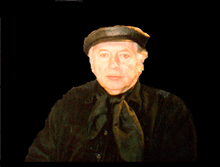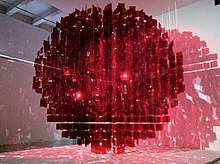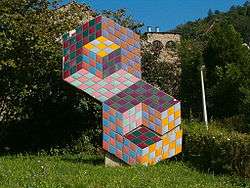Julio Le Parc
Julio Le Parc (born September 23, 1928) is an Argentina-born artist who focuses on both modern op art and kinetic art. Le Parc attended the School of Fine Arts in Argentina. A founding member of Groupe de Recherche d’Art Visuel (GRAV) and award-winning artworks, he is a significant figure in Argentinean modern art.[1]
Julio Le Parc | |
|---|---|
 | |
| Born | September 23, 1928 Mendoza, Argentina |
| Nationality | Argentina |
| Education | School of Fine Arts |
| Movement | Groupe de Recherche d'Art Visual (GRAV) |

Life
Julio Le Parc was born into a family of limited economic means. At age thirteen he moved with his mother and brothers to Buenos Aires.[2] While there he attended the School of Fine Arts and showed growing interest in artistic avant-garde movement in Argentina.[2] The School of Fine Arts is where Le Parc, along with fellow artists Hugo Demarco, F. García Miranda, Francisco Sobrino, Horacio García Rossi, Molnar, François Morellet, Sergio Mǫyano Servanes, Jean-Pierre Yvaral, and Jöel Stein formed the Groupe de Recherche d’Art Visuel, or GRAV.[2]
A precursor of Kinetic Art and Op Art, founding member of Groupe de Recherche d’Art Visuel[3] and recipient of the Grand Prize for Painting at the 33rd Venice Biennale in 1966, Julio Le Parc is a major figure in modern art history. The socially conscious artist was expelled from France in May 1968, after participating in the Atelier Populaire and its protests against major institutions.
He currently lives and works in Cachan France.
Career
Early
Julio Le Parc found an interest in art at the age of thirteen when it was evident that, while he was a mediocre student, he was exceptional at sketching portraits and illustration cards.[1] His environment, mainly being the School of Fine Arts significantly influenced the early part of his career. While there he attended night classes while working full-time. Le Parc took a special interest in the avant-garde artistic movements in Argentina: Movement of Arte Concreto Invencion.[1] After attending the School for four and a half years he decided to leave the school and the area. He decides to go travel the country, not speaking to his family for eight years. He later returns to the Academy of Fine Arts, where he takes an active role in student movement groups. Julio Le Parc graduated from the Academy of Fine Arts with Luis Wells and Rogelio Polesello.[4] After returning, in 1958 Le Parc received a grant from the French Cultural Service to go to Paris, France.[5] Much of his early career was committed to painting, engraving and creating monotypes. However, in 1959 Le Parc begins his experimentation with image produced by light multiplied by layers of planes of Plexiglas. Le Parc participated in his first exhibition, Bienal de Sáo Paulo in Sáo Paulo, Brazil in 1957.
Middle
Upon arriving in Paris in 1958 he connected with Jesús Rafael Soto and Carlos Cruz-Diez who were already in Paris.[5] There they met Victor Vasarely, Georges Vantongerloo, Morellet, and Denise René, whom they became friends with.[6] René, a French dealer, was committed to the promotion of abstract art, and later helped launch kineticism.[6] Upon building relationships with these fellow artists and moving permanently to Paris, Le Parc began to paint what came to be known as Surfaces Sequences. These are works in which the progression of forms with slight variations create illusions of rhythmic movements when completed.[5] In 1960 the GRAV group was established with the collective strategy to delegate the creative act to the viewer. The group advocated for art to play a wider and more active role in society.[6]
In 1966, Le Parc won the Grand Prize in Painting at the 33rd Biennale di Venezia, Venice.[5] He had been living in Paris for eight years at the time of receiving the award.[5] By this time, Le Parc had invested himself in experiments with light. Le Parc had personal experiences with light and mobiles in a translucid cube, as well as an animated piece of light projected on ceilings, walls and the floor.[5] He was also experimenting with light on a reflecting cylinder.[5]
A defender of human rights, he fought against dictatorship in Latin America. In 1972 he refused to hold a retrospective exhibition at the Musée d'Art Moderne de la Ville de Paris, after flipping a coin to make the decision.[7]
Late
Le Parc has continued his use of light and kinetics. However, "in the 1970s, Le Parc's artistic activities became less frequent, to the degree that his work almost went unnoticed in the international arena for several decades".[5] Nonetheless, with a renewed interest in using light as a medium, Le Parc's work is being brought to the attention of a wider public.[5]
In 2004 he produced with Yvonne Argenterio in the Elettrofiamma workshops, Italy, a series of sculptures (Torsions) presented at the event "Verso la Luce", in the Castle of Boldeniga (Brescia, Italy). The monumental sculpture "Verso la Luce" is still visible in the castle garden. He received a one-man show at the Palais de Tokyo in Paris in 2013.[7] He is socially committed to immersive art.
Selected Artworks
Mobil Transparent theme, 1960
Mobil Transparent theme is made up of small pieces of Plexiglas connected together like a translucent cascade flowing from the ceiling.[8] This work was the most highlighted work in his exhibition in Miami, Florida in 2011. This work was placed at the center of the main room, allowing the viewer to walk around it to see all the different angles reflected on a mirror directly below it on the floor.[8] Le Parc made an additional version of this work, originally from 1960, for the exhibition in Miami.
Light in Movement, 1962
Light in Movement is another sensorial artwork as with all of Le Parc's works, which did not aim to be a narrative but experienced-based. The piece is made up of painted drywall, mirrors, stainless steel, nylon thread and two spotlights. [9] The work is approximately 42 ft. x 16 ft. x 16 ft. This artwork is found inside a dark semi-circular hallway where light is experienced as both a reflection and refraction.[9] The viewer stands below the work and observes the myriad of twinkling lights around the space. This piece was also re-fabricated in 2010 for its installation at the Geffen.[9] As with many of Le Parents arc's works form this time, in an interview with Alma Ruiz on MOCAs website, this piece focuses on the "visual experience and omits the anecdotal".[9] Le Parc along with the other member of GRAV focused heavily on the viewers experience and interaction with the artworks.
Celule Avec Luminere un Vibration, 1968
Similar to the Mobil Transparent theme, this piece was also a part of the Miami exhibition in 2011. The intention of Celule Avec Luminere un Vibration is to incorporate light and the sensorial experience of the viewer. This piece is from 1968 and is 150 x 157x 137 in.[6] A projector displays light on a wall and changes pattern in a rhythmical way that appears to be a vibration.[8] This piece was placed in a separate room by itself away from the other artworks to help the viewer enjoy the experiences of light and sound.[8] The goal was to make the viewer feel as though they were isolated from the rest of the world.
Alchemy 175 and 216, 1991-92
One of Le Parc's key endeavors is the Alchemy series. He used two paintings from this series in the Miami exhibition of 2011, Alchemy 175 and Alchemy 216.[8] The Alchemy series is titled Alchemy, followed by a number representing the order that it was created. Alchemy 175 is from 1991, and Alchemy 216 from 1992.[8] These two pieces are claimed to be Le Parc's tribute to this science as they both explore the significance of water. Water is referred to as one of the four main elements of nature and is the symbol of flux, renovation and purification.[8] He is again exploring movement, however in these paintings he uses water, he does this by painting fountains sprinkling water in an umbrella form and using light to change the perception of the viewer.[8]
Modulation 1160, 2004
The Modulation series is another significant series Le Parc has been working on since the early 70's. Again, similar to the Alchemy series, this series is titled Modulation, followed by a number in the order that it was created.[8] Modulation 1160 is a work from 2004 in which many believe this is one of the finest works from the Modulation group.[8] The piece is split into quarters, right in the middle from the top to the bottom with what appears to be a ray of light, and side to side with a structure that looks like an open fan. The work is acrylic on canvas and measures 39 ½ x 39 ½ in.[8] This painting gives the illusion of movement of both the light and the fan at the same time. It appears that the light is actually activating the fan, thus putting it into motion.[8] The Modulation series consists of hundreds of different works that Le Parc describes as experiments.[8]
Additional Artworks
- Images projetées, 1962
- Sol instable, 1964/2005
- Retrospectiva, Instituto Di Tella, Buenos Aires, 1967
- Rubans au vent, 1988
- Lumière sur mât, 1999[10]
Exhibitions
Solo
- Perez Art Museum Miami (PAMM), Miami, Florida, USA, 2016
- Serpentine Sackler Gallery, London, United Kingdom, 2014
- Palais de Tokyo, Paris, France, 2013
- Otra Mirada, Buenos Aires, Argentina, 2010
- Le Parc. Lumière. La Habana, Cuba, 2009
- Julio Le Parc et Vertige Vertical. Cachan, France, 2005
- Julio Le Parc - Verso la Luce - TORSIONS, scultura monumentale permanente nel giardino del Castello di Boldeniga-Brescia(Italia), 2004
- Alquimias. Quito, Ecuador, 1998
- Salle de jeux et travaux de surface. Arcueil, France, 1996
- Obra reciente. Valencia, Spain, 1991
- Modulazioni di Julio Le Parc. Brescia, Italy, 1988
- Galleria La Polena, Genova, Italy, 1979
- Galerie Denise René, New York, New York, USA, 1973
- Kinetische Objekte. Ulm, Germany, 1970
Group
- Flash! Light and Movement. Tampere, Finland, 2009
- 50 años de pintura geométrica latino-americana. La Plata, Argentina, 2002
- Portes ouvertes. Cachan, France, 1994
- I Bienal de Cuenca. Cuenca, Ecuador, 1987
- Arte Programmata e Cinetica 1953-1963. Milano, Italy, 1983
- Brigade International de Peintres Antifascistes. Athens, Greece, 1975
- Kinetics. London, UK, 1970
- Light in Orbit. New York, New York, USA, 1967
- Groupe de Recherche d'Art Visuel. Paris, France, 1960
- IV Bienal de São Paulo. São Paulo, Brazil, 1957[10]
References
- López, S. (2005). Le Parc Lumiere: Cinetic Works. Ostfildern-Ruit: Hatje Cantz, p.184-185.
- Katzenstein, I. (2004).Listen, Here, Now!: Argentine art of the 1960s: writings of the Avant-Garde. New York: Museum of Modern Art, p. 341.
- Ian Chilvers & John Glaves-Smith, A Dictionary of Modern and Contemporary Art. Oxford University Press, p. 403
- Ledezma, J. C., Cisneros Fontanals Art Foundation., Ella Fontanals-Cisneros Collection. (2007). The sites of Latin American abstraction. Milano: Charta.
- Ruiz, A. & Museum of Contemporary Art (Los Angeles, Calif.). (2011). Supra sensorial: Experimentos en Luz Color, y Espacio = Experiments in Light, Color, and Space. Los Angeles: The Museum of Contemporary Art.
- Salgado, G. (2005). Julio Le Parc: The Low-Tech, High-Magic of Light Works. Art Nexus, 4(58), 102-105.
- JULIO LE PARC Date: 27/02/2013 - 13/05/2013 Archived 2013-06-20 at the Wayback Machine
- Leyva, I. (2011). Julio Le Parc. Art Nexus, 10(80), 99-100.
- Preciado, S. (2011). Suprasensorial: Emperiments in Light, Color, and Space. Art Nexus, 10(80), 116-117.
- Le, P.J., Steffen, K., Casa Daros. (2013). Julio Le Parc: Kinetic Works. Ostfildren: Hatje Cantz, p. 248-251.
External links
- Official website
- Julio le Parc at the Serpentine Galleries 2014
